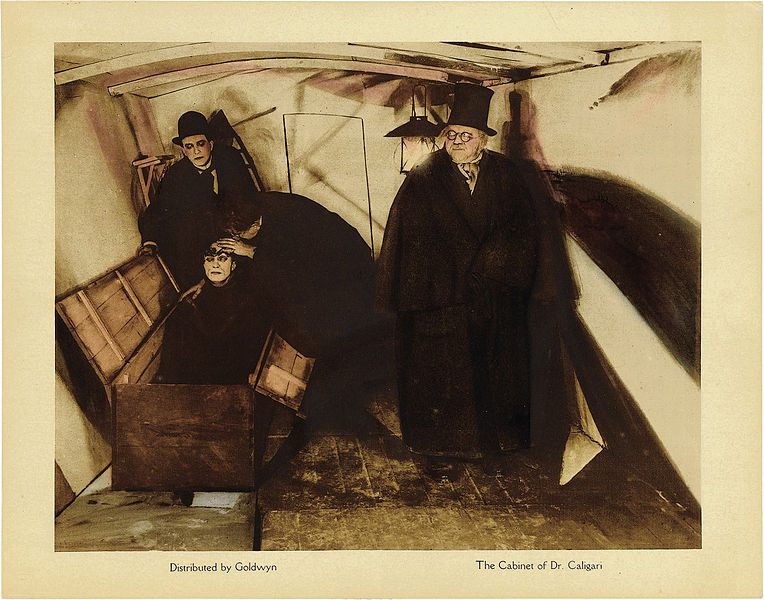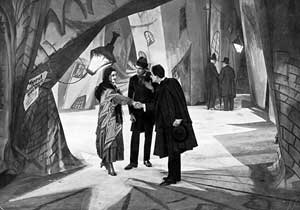The Mad Doctor Meets the Somnambulist
Cad a tharlaíonn é an chéad scannán ealaíne tráchtála rathúil. An Comh-Aireachta an Dr. Caligari (1920) scaoileadh i mí Eanáir 1920 bheith ina ceint na Gearmáine agus idirnáisiúnta. Ba é an tús le hathbheochan scannán na Gearmáine i rith na 1920í
The German Expressionist Movement in German art strongly influenced this film. Tharraing péintéirí Eispriseanachais foirgnimh le fána corruillinneacha, oddly shaped furniture, etc.
The film’s set design reflected this style of composition. Buildings, doors and streets all slope at odd angles or are irregular shapes. Furniture is also oddly shaped. Chairs seats are six feet in the air, bookcases lean and chairs have irregular backs.
Robert Weine filmed in a standard continuity format making the story understandable to the average viewer. The story itself is a horror and detective story told from one man’s perspective, a story within a story.
A mysterious stranger named Dr. Caligari, a bhí ag Werner Krauss, go Hollstenwall chun somnambulist Cesare a thaispeáint, portrayed by Conrad Veidt. A somnambulist sleeps for days on end. Deir Calagari gur chodail Cesare ar a shon 20 to 30 bliana. Coincidentally or not, a series of murders occur once Caligari and Cesare arrive in Hollstenwall.
The protagonist of the film is Francis (Friedrich Feher), who is in love with Jane (Lil Dagover). Fiends anaithnid dúnmharú Francis’ cara le Francis chun dul sa tóir ar an Dr. Caligari, a chreideann Proinsias atá freagrach as an dúnmharú.
Tiomáineann an teannas leanúnach idir Francis agus Caligari an scéal, which is complicated by Cesare’s infatuation with Jane, Francis’ love interest.
Scannánaíocht Weine deireadh casta nach millfidh mé duit. Scríobh Hans Janowitz agus Carl Mayer an scannán agus chuir siad go láidir i gcoinne athruithe Weine. Níor chreid Weine go nglacfadh lucht féachana leis an scannán gan deireadh a chur leis.
You will want to view this movie on the Special Collector’s Edition DVD, which restored the film to its original speed of 18 feet per second. American films were shot at 24 feet per second. When the original copies for video distribution were made, a copy of the film was recorded on a 24 feet per second projector. The recording at a different speed made the film look a bit quirky and rushed. The film actually has a very deliberate pace, when viewed at the proper projection speed.
The Expressionist scenery will distract you at first. When I first watched the film about ten years ago for a college class, my wife and kids thought I was watching some 1960s psychedelic drug film. Even after explaining Expressionism, they thought it was odd. All three of my children have watched the film to mixed reviews. I will let you decide on the film yourself.
Nuashonraigh: I recently saw the restored version on Netflix. I recommend this copy also.
You can leave a comment or ask a question about this or any post on my Facebook page.
Bioráin sé



